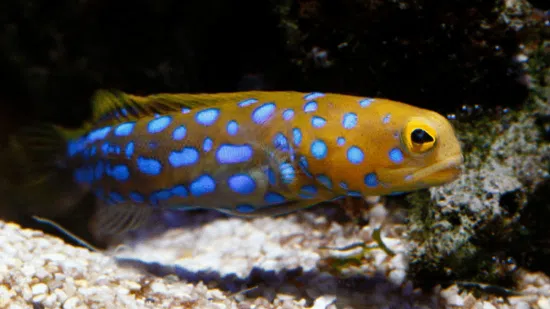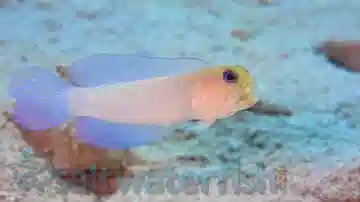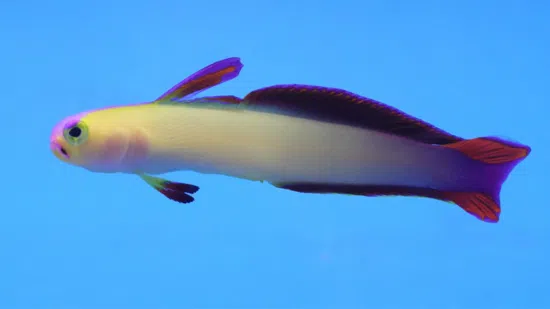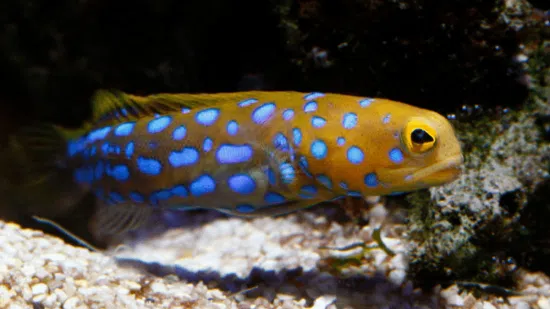Blue Spotted Jawfish
Opistognathus rosenblatti
(4 Reviews)

Blue Spotted Jawfish
Opistognathus rosenblatti
(4 Reviews)
{{ item.name }}
Size: {{ item.extra_field_3 }}
${{ getFormattedPrice(item.saleprice) }} ${{ getFormattedPrice(item.price) }}
To join the waiting list, click here
Free Shipping
With
$199.00
or more in Marine Life.
More details...
Blue Spotted Jawfish Care Facts
| Care Level: | Easy |
|---|---|
| Temperament: | Peaceful |
| Diet: | Carnivore |
| Reef Safe: | Yes |
| Minimum Tank Size: | 30 gallons |
| Max Size: | 4 inches |
Keeping the Blue Spotted Jawfish (Opistognathus rosenblatti) in Your Saltwater Aquarium
The Blue Spotted Jawfish, scientifically known as Opistognathus rosenblatti, is a fascinating and visually striking addition to saltwater aquariums. This informative guide will provide comprehensive information on the care and maintenance of the Blue Spotted Jawfish. We will cover essential topics such as their habitat, reef compatibility, size, lifespan, dietary requirements in captivity, aquaculture availability, compatibility with other marine species, sexual dimorphism, juvenile to adult coloration changes, temperament, specific tank requirements, and precise water conditions. Additionally, we will list common names for this species and explain why choosing the Blue Spotted Jawfish from Saltwaterfish.com is a sound decision.
Habitat and Natural Range of Blue Spotted Jawfish
The Blue Spotted Jawfish is native to the cooler vibrant waters off the California Coast, where it primarily inhabits sandy substrates near coral reefs. They are known for their distinctive burrowing behavior, creating intricate tunnels in the substrate that serve as their shelter and protection.
Reef Compatibility of Blue Spotted Jawfish
The Blue Spotted Jawfish is typically considered reef-safe. Their burrowing behavior does not pose a threat to corals or other invertebrates. They can benefit a reef ecosystem by oxygenating and turning over the substrate as they create and maintain their burrows.
Size and Lifespan of Blue Spotted Jawfish
Blue Spotted Jawfish are relatively small, with an average size ranging from 3 to 4 inches (7.5 to 10 centimeters). They can live up to 5 years in a well-maintained aquarium with proper care, providing long-term enjoyment.
Diet in Captivity for Blue Spotted Jawfish
Blue Spotted Jawfish are carnivorous in their natural habitat, primarily preying on small invertebrates and zooplankton. To ensure their health in captivity, it's essential to provide a diverse diet that includes:
- Live or Frozen Foods: Offer a variety of live or frozen foods such as brine shrimp, mysis shrimp, and other small marine invertebrates. These should be the primary components of their diet.
- Dry Foods: High-quality marine-based dry foods in pellets or flakes can supplement their diet. However, live or frozen foods should remain their primary source of nutrition.
Aquaculture and Availability of Blue Spotted Jawfish
Aquacultured Blue Spotted Jawfish are not as common as some other marine species but are occasionally available in the aquarium trade. To ensure you acquire healthy and well-acclimated specimens, it's essential to choose reputable suppliers like Saltwaterfish.com.
Compatibility with Other Fish and Invertebrates for Blue Spotted Jawfish
Blue Spotted Jawfish are generally peaceful and can coexist with various marine species, making them suitable for a community tank. Here are five compatible companions:
- Firefish (Nemateleotris spp.): Peaceful and visually striking, Firefish are an excellent match for Blue Spotted Jawfish.
- Clownfish (Amphiprion spp.): Clownfish and Blue Spotted Jawfish can coexist harmoniously and are a classic pairing in reef tanks.
- Blennies (Ecsenius spp.): Most blennies are peaceful and suitable for reef tanks.
- Gobies (Gobiidae family): Many goby species share a peaceful temperament and are compatible with the Blue Spotted Jawfish.
- Small Wrasses (Labridae family): Certain species of small wrasses are peaceful and can be kept alongside Blue Spotted Jawfish.
Sexual Dimorphism of Blue Spotted Jawfish
Blue Spotted Jawfish do not exhibit significant sexual dimorphism, which means distinguishing males from females based on physical characteristics can be challenging.
Juvenile to Adult Coloration Changes in Blue Spotted Jawfish
Juvenile Blue Spotted Jawfish typically exhibit vibrant blue coloration with distinct dark spots on their dorsal fin, which is the source of their common name. As they mature into adults, their coloration may become richer and more vivid, adding to their visual appeal.
Temperament of Blue Spotted Jawfish
Blue Spotted Jawfish are known for their peaceful and non-aggressive nature. They are not territorial and generally keep to themselves, focusing on their burrowing activities.
Tank Requirements for Blue Spotted Jawfish
To ensure your Blue Spotted Jawfish thrives in its environment, adhere to these tank requirements:
- Minimum Aquarium Size: A tank with at least 30 gallons capacity is recommended for a single Blue Spotted Jawfish. Larger tanks offer more space and opportunities for additional tank mates.
- Substrate: Use fine sand as the substrate, as Blue Spotted Jawfish are known for their burrowing behavior and require soft substrate for their burrows.
- Rock Structures: Incorporate live rock structures in the aquarium. These can provide shelter and hiding spots, which Blue Spotted Jawfish may use as starting points for their burrows.
- Water Temperature: Maintain a stable water temperature between 69°F and 74°F as they prefer cooler water.
- pH: Keep the pH level within the range of 8.1 to 8.4 to support optimal biological processes.
- Salinity: Maintain a stable salinity level between 1.023 and 1.025 to replicate the conditions of their natural habitat.
Precise Water Conditions for Blue Spotted Jawfish
To ensure the health and vitality of your Blue Spotted Jawfish, maintain the following water conditions:
- pH: Maintain the pH level in the range of 8.1 to 8.4 to support proper biological functions.
- Salinity: Maintain a stable salinity level between 1.023 and 1.025 to mirror their natural habitat conditions.
- Water Temperature: Keep the water temperatures cooler at a consistent 69°F to 74°F.
- Water Flow: Blue Spotted Jawfish prefer low to moderate water flow in the aquarium. Ensure the water movement is not too strong, as it may disrupt their burrows.
Common Names of Blue Spotted Jawfish
The Blue Spotted Jawfish may also be called the Blue Spot Jawfish, Blue Dot Jawfish, or Blue Speckled Jawfish.
Why Choose the Blue Spotted Jawfish from Saltwaterfish.com?
Selecting the Blue Spotted Jawfish from Saltwaterfish.com offers numerous benefits:
- Healthy Specimens: Saltwaterfish.com is dedicated to providing customers with robust, healthy Blue Spotted Jawfish that have been properly acclimated.
- Reliable Source: By choosing Saltwaterfish.com, you ensure the acquisition of responsibly sourced and ethically collected marine species.
- Expert Guidance: Saltwaterfish.com offers expert guidance and support to help you provide the best possible care for your Blue Spotted Jawfish in your saltwater aquarium.
In summary, the Blue Spotted Jawfish is an intriguing and visually captivating species that can be an exciting addition to your saltwater aquarium. When maintained correctly, Blue Spotted Jawfish can be a delightful and peaceful member of your marine community. Selecting the Blue Spotted Jawfish from Saltwaterfish.com ensures you receive healthy, ethically sourced specimens and access to expert guidance for their care.
My Blue Spotted Jawfish just arrived today and he's everything I hoped for. I was worried because today was in the upper 90°s and figured he had a heat pack which it did. The box including the inside was pretty warm. He's a strong little fella! Acclimated him a little bit more slowly due to the temp (since they prefer it a little cooler) and he's doing amazing. He started digging out his home within four a few hours. I'm so happy to have this beautiful Goby in our water world! First purchase with Saltwater Fish and I was very happy with the overall process. The weather is no one's fault.
Reviewed by: Travis on June 17, 2022
My favorite fish of all time
Reviewed by: Daniel Roos on Jan. 23, 2022
I have this goby for about a month now. I was surprised to find how active it is (unlike other gobies). It swims alot during the day. It opens its mouth when it senses danger ie when another fish swims close to it. The negative is the cost but I find this fish a joy to have in my tank.
Reviewed by: Esther Murphy on Feb. 15, 2018
By far my favorite fish. I had to empty a display into my qt tank so that it could be qt'd in a tank with sand in it. Awesome colors and awesome personality. Been here a week and no signs of parasite or illness.
Reviewed by: Josh Cutler on Feb. 19, 2017








